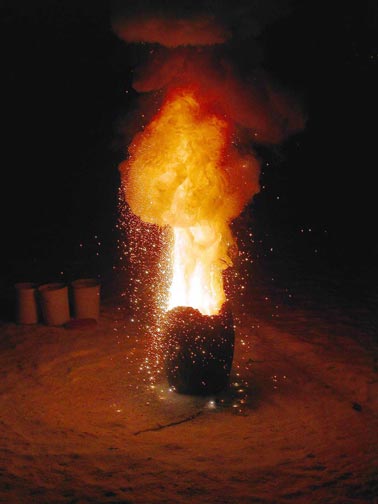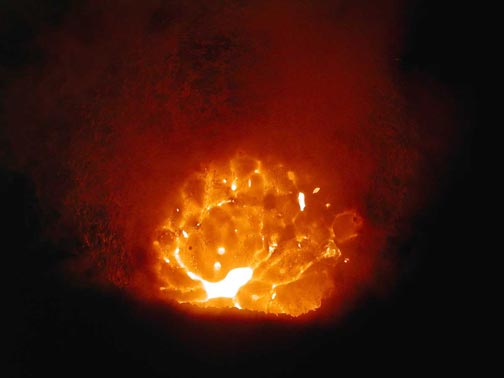The most exothermic reaction
 Common iron rust reacts with aluminum to create corundum and molten iron.
Common iron rust reacts with aluminum to create corundum and molten iron.
Ingredients: ferric oxide, aluminum powder, black powder
Procedure: A complete recipe follows.
1. Mix 1.0 gram of aluminum powder with 3.0 grams of ferric oxide powder.
2. Place mixture in crucible.
3. Add "primer" of black powder.
4. Ignite primer and stand back.
Understanding: This powerful thermite reaction will give you a great show of light, heat, and flowing molten iron. Think of trying to melt an iron skillet using all of the heat you can produce in your kitchen. Perhaps you can reach a temperature of 370C (700F) on your stove top, but that is far below the melting point of iron 1539C (2802F) at atmospheric pressure!
In this reaction, the aluminum bargains with the iron, trading its electrons for the iron's oxygen atoms. The oxygen atoms are neither reduced or oxidized. The aluminum is oxidized and the iron is reduced
2 Al(s) + Fe2O3(s) → 2 Fe(s) + Al2O3(s)
 When the reaction product has cooled, we notice that the
mixture of red iron oxide rust and gray aluminum powder was converted
to a clump of iron and chips of the deep grey mineral corundum -- a form
of aluminum oxide. If we test the corundum, we find it hard but brittle.
Why is it brittle? That is a result of being quickly cooled from its
molten state. Not able to form a strain free crystal, the molecules
of aluminum oxide are frozen into a glassy, disordered, and strained
arrangement. As a result, it will crack easily.
When the reaction product has cooled, we notice that the
mixture of red iron oxide rust and gray aluminum powder was converted
to a clump of iron and chips of the deep grey mineral corundum -- a form
of aluminum oxide. If we test the corundum, we find it hard but brittle.
Why is it brittle? That is a result of being quickly cooled from its
molten state. Not able to form a strain free crystal, the molecules
of aluminum oxide are frozen into a glassy, disordered, and strained
arrangement. As a result, it will crack easily.
What of the iron? We can test it to see if it is magnetic. At times, the product of this reaction produces magnetic iron. At other times, the product is non-magnetic iron. The two forms result from different rates of cooling of the molten iron. A slow cooling results in a better formed crystalline state of iron that is magnetic. When the molten iron is quickly quenched in a rapid cooling, the iron is frozen into random orientations and there is no microscopic atomic ordering required to create a prevailing, macroscopic magnetism.
We can vary the rate at which the molten iron cools, by cooling it slowly in air or by quenching the reaction with water or ice. Measuring the magnetic properties of the resulting iron will demonstrate how the rate of cooling influences the resulting magnetism.
Now let's think about the enthalpy change in this reaction. How can we understand the enormous exothermicity? A useful approach is through the thermodynamic cycle. Here is how that works. We imagine that we can form the reactants from the necessary elements. For example, iron from solid iron, oxygen from dioxygen gas, aluminum from solid aluminum. Each reaction is a formation reaction, and the associated change in enthalpy will be the enthalpy of formation, ΔHfo. For example, we can think of the formation of ferric oxide from the elements
2 Fe(s) + 3/2 O2(g) → Fe2O3(s) ΔHfo[Fe2O3(s)] = -824.2 kJ
The same can be done for the product aluminum oxide
2 Al(s) + 3/2 O2(g) → Al2O3(s) ΔHfo[Al2O3(s)] = -1675.7 kJ
What about the Fe(s), Al(s), and O2(g)? We say that the enthalpies of formation are zero. We can do that because the enthalpy change in a reaction depends only on the final state and the initial state of the system. So we can measure the changes in enthalpy, but not an absolute value of the enthalpy. For convenience, we set the zero to be the form of that element at standard state. So iron is the solid iron crystal and oxygen is the gaseous dioxygen, and so on.
Now we recall that the enthalpy is a state function. The change in enthalpy for the reaction will depend on the initial and final states, but will be independent of the path for the transformation. So we can construct our imagined path: starting from reactants (1) transform the reactants to their elemental form and (2) transform the elements into products. Why is that useful?The enthalpy change in the second step is the enthalpy of formation of the products from the elements
ΔHfo[reactants] = ΔHfo [Fe2O3(s)] + 2 ΔHfo[Al(s)]
The enthalpy change in the first step is the enthalpy change to create the elements from the reactants, which is just the negative of the sum of the enthalpies of formation of the reactantsΔHfo[products] = ΔHfo [Al2O3(s)] + 2 ΔHfo[Fe(s)]
If we add the change in enthalpy for each of the two steps together, we have the change in enthalpy for the direct transformation of reactants to productsΔHo = ΔHfo[products] - ΔHfo[reactants] = -1675.7 kJ - (-824.2 kJ) = -851.5 kJ
This terrifically useful result is known as Hess's Law. It is a special case of the very general idea of the thermodynamic cycle. Using Hess's Law and a table of heats of formation of various molecules, we can accurately predict the change in enthalpy for reactions that have never been performed!
Variations on the thermite reaction
Question: There are limitless variations on the highly popular thermite reaction using a number of metal oxides. In each reaction, we can expect to experience a great show of light and heat. The basic chemistry is that of an oxidation/reduction reaction where aluminum powder reacts with a metal oxide, stealing the metal oxide's oxygen to form aluminum oxide, and leaving reduced metal.Write the balanced equation for a variation on the thermite reaction, involving the reaction of aluminum metal with cobalt(II) oxide. Identify another metal oxide that might be used in a variation on the thermite reaction.
You can check your answers here.
The reaction of aluminum with iron oxide demonstrates the impressive stability of aluminum oxide. That raises the question, with all of the oxygen in our atmosphere, why is it that bars of aluminum resist oxidation so effectively, while bars of iron are highly susceptible to rusting?
You can check your answers here.
Stability of metallic aluminum in an aerobic atmosphere
Question:
What is the most abundant metallic element in the Earth's crust? Aluminum! In fact, aluminum is the third most abundant element in the Earth's crust (7.5%), behind oxygen (49.2%) and silicon (25.7%).
Aluminum metal is derived from mineral deposits of bauxite, which is a mixture of hydrated aluminum oxides. The aluminum in the oxides is reduced to produce metallic aluminum, which is ductile and light weight.